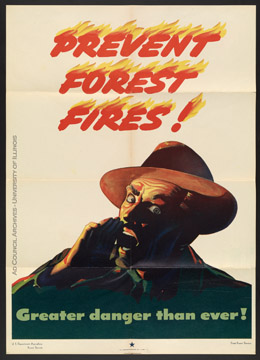Aside from records related to the University and surrounding communities, the University of Illinois Archives is also custodian of the records of many outside associations. Among these are the records of the Ad Council, a long-running non-profit organization that works with advertising agencies, media companies, and private businesses to produce and distribute public service advertising. The Ad Council is directly or indirectly responsible for many memorable public service campaigns in print, radio, and television media. The longest-running of these is their Forest Fire Prevention campaign, featuring the well-known spokescharacter Smokey Bear. But do you know how this public safety icon came to be?

Found in Ad Council Transit Ads, 1944-2004, RS 13/2/217
During World War II, the American lumber industry and the US government increased their efforts to prevent forest fires:
“There has always been organized effort to fight forest fires, ever since our country has had a lumber industry, and there always will be. But right now the loss of this great national resource — whether due to enemy saboteurs or to sabotage by our own carelessness — directly damages war plants, industrial establishments and farm lands and diverts valuable man-hours from production to fire fighting. Smoke from forest fires has caused the loss of more than 10,000 flying hours in a single aviation camp, interrupted anti-aircraft training, suspended military training schedules entirely while troops fought range and forest fires…our loss is the Axis’ gain.”
“Each year, America suffers from 140,000 to 220,000 forest fires and of these 90% are man-made and thus preventable…Advertising, through education and reminder and warning, can combat the sabotage of our forests, ranges and woodlots.”1

Found in Ad Council Historical File, 1941-1997, RS 13/2/207, File 337
It was in this spirit that the Cooperative Forest Fire Campaign was established in 1942, a partnership among the War Advertising Council (as the Ad Council was then known), the federal Office of War Information (OWI), and the US Dept. of Agriculture Forest Service.
The campaign produced and distributed several posters between 1942 and 1944, intended to inform the public of the danger and preventability of forest fires. In 1943, the campaign was granted the limited use of characters from the Walt Disney animated feature Bambi for one of these posters. It proved popular with the public and Forest Service employees (“a hit everywhere”), and the Forest Service was in favor of either reusing it, or better yet, creating “something like it that will appeal to children” and would be free of copyright entanglements.2

Found in Ad Council Historical File, 1941-1997, RS 13/2/207, File 124
In addition, a 1944 poster featured a shouting forest ranger, with the tagline “Greater Danger Than Ever!” Although effective at reminding park visitors of their responsibilities, reactions from Forest Service employees were mixed. Some forest officers derided the image as “wild-eyed” and “screaming”, and many noted that the hat depicted was “not standard equipment”.3

Found in Ad Council Ready Reference Files, Forest Fire Prevention
Given the reactions to these two efforts, it is hardly surprising that the 1944-45 campaign introduced an original animal character with a calm demeanor. And the right hat.
“Mr. Dulany of OWI reported that an additional poster showing a ‘bear’ character was now being prepared. It was proposed that this be used for book covers and as a poster. Mr. Hammatt intends, we understand, to confine its use to these two items.”4
The astute reader will realize that the use of this “bear character”, unlike Bambi and friends, has NOT been particularly limited, and Smokey eventually appeared on more than just two promotional items. Smokey Bear has endured almost 70 years, and what is now called the Wildfire Prevention campaign has become the Ad Council’s longest running public service campaign, helping save millions of acres of forest and wildlands from fire.5
References
1. War Advertising Council Staff (January 20, 1944). Summary for the use of Sponsorship Committees on Forest Fire Prevention. Ad Council: Washington Office Subject File, 1942-1990, Record Series 13/2/305, Box 2, Ad Council Archives, University of Illinois at Urbana-Champaign.
2. Hammatt, R.F. (July 22, 1944). Suggestions, Data, Material etc. for the 1945 Wartime Forest Fire Prevention Program. Ad Council: Washington Office Subject File, 1942-1990, Record Series 13/2/305, Box 2, Ad Council Archives, University of Illinois at Urbana-Champaign.
3. R.F. Hammatt to Russell Z. Eller (July 22, 1944). Ad Council: Washington Office Subject File, 1942-1990, Record Series 13/2/305, Box 2, Ad Council Archives, University of Illinois at Urbana-Champaign.
4. Conference Report. Forest Service campaign meeting, Washington, DC. (September 5, 1944). Ad Council: Washington Office Subject File, 1942-1990, Record Series 13/2/305, Box 2, Ad Council Archives, University of Illinois at Urbana-Champaign.
5. Ad Council. (2013). Wildfire Prevention. http://www.adcouncil.org/Our-Work/The-Classics/Wildfire-Prevention. Accessed July 10, 2013.